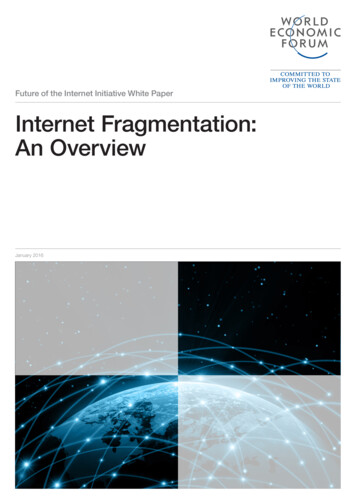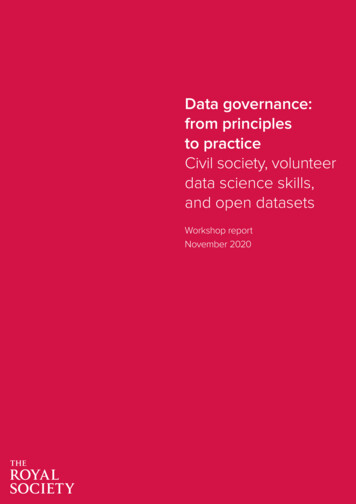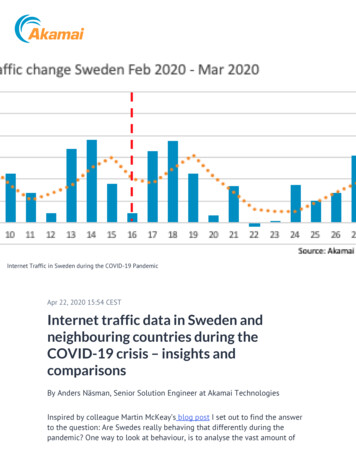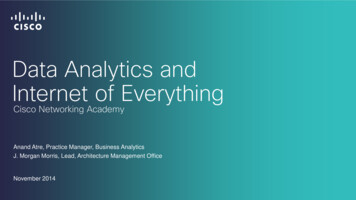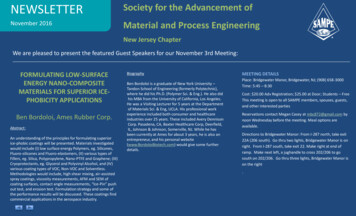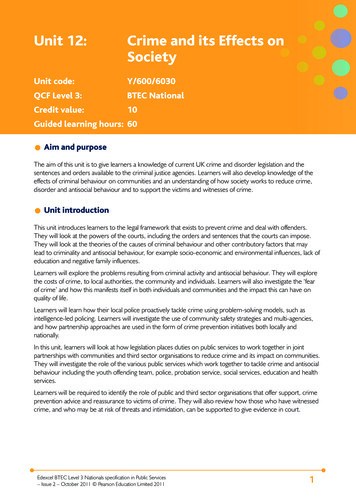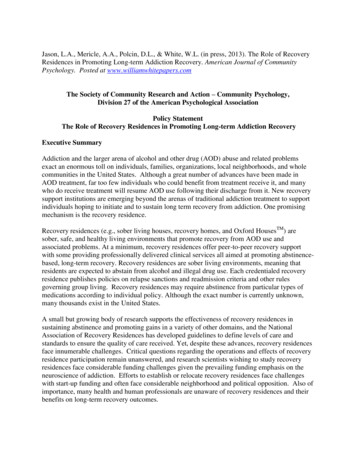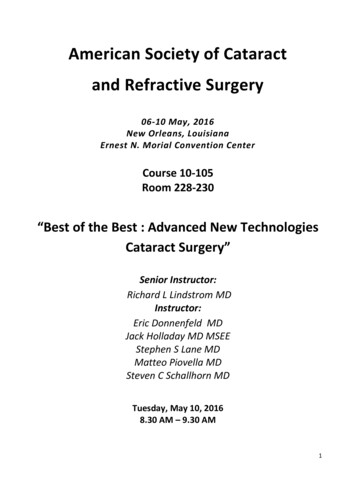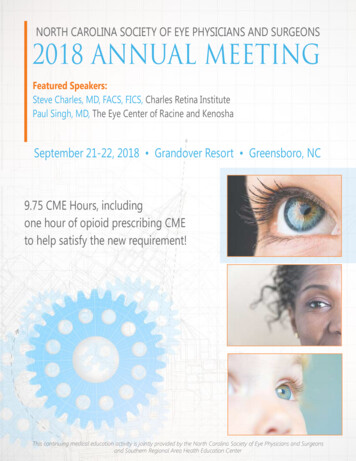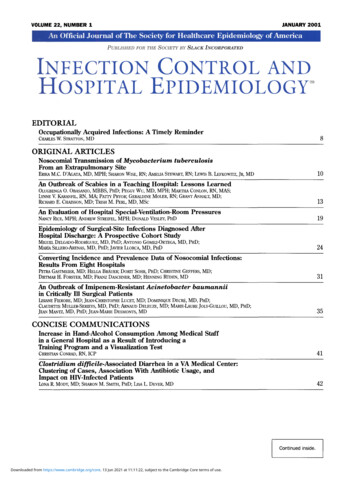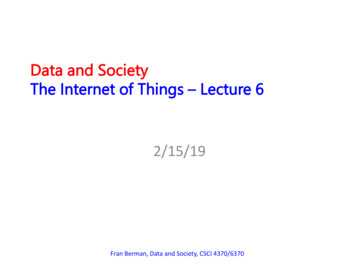
Transcription
Data and SocietyThe Internet of Things – Lecture 62/15/19Fran Berman, Data and Society, CSCI 4370/6370
Announcements 2/15 Class Wednesday February 20. Op-Ed drafts due next week (February 22) at thebeginning of class. Please turn in the assignment inhardcopy. No late work. New day for Topic Presentations added: April 17Fran Berman, Data and Society, CSCI 4370/6370
Topic Group Presentations – PLEASE LET FRAN KNOW IFALL MEMBERS CANNOT MAKE IT March 20 [4] April 26 [4]– Xavier, Marissa, Raz, Chang– Rufeng, Yawen, Ethan– Andrew, Korryn, Nancy, Charles– Randy, JD, Alex, Noah– Clarisse, Jessie, Meredith– Milena, Josephine, Jacob– Rachel, Kevin, Guannan, David– Chris, Aayushi, Peter April 17 [3]– Samad, Jimmy, Priya, Yuming– Rahul, Grace, Lexie– Brianna, Heather, NkechinyereFran Berman, Data and Society, CSCI 4370/6370
Wednesday SectionJanuary 9: NO CLASSFriday Lecture (first half)January 11: INTRO– DATA AND SOCIETYSecond half of classAssts.Fran presentation demoJanuary 16: NO CLASSJanuary 18: BIG DATA 1; Topic groups / Topicmaterials informationJanuary 25: BIG DATA 2Student presentationsFebruary 1: DATA AND SCIENCEStudent presentationsJanuary 23: StudentpresentationsJanuary 30: NO CLASSFebruary 6: NO CLASSStudent presentationsOp-Ed instructionsFebruary 8: DATA STEWARDSHIP ANDPRESERVATIONFebruary 13: NO CLASS February 15: INTERNET OF THINGSStudent presentationsGroup Topics dueFebruary 20: StudentFebruary 22: DATA AND PRIVACY /presentationsFOUNDATIONSFebruary 27: NO CLASS March 1: DATA AND PRIVACY / POLICY ANDREGULATIONMarch 6: Spring Break March 8: Spring BreakMarch 13: StudentMarch 15: DATA AND ENTERTAINMENT [ANDYpresentationsMALTZ]March 20: TOPICSMarch 22: DATA AND DATINGPRESENTATIONS 1 [4]March 27: StudentMarch 29: DIGITAL RIGHTS 1presentationsApril 3: NO CLASSApril 5: DIGITAL RIGHTS 2Student presentationsOp-Ed Drafts dueStudent presentationsBriefing instructionsStudent presentationsOp-Ed Drafts ReturnedTopic Reports 1 dueApril 10: StudentpresentationsApril 17: TOPICPRESENTATIONS 2 [3]April 24: StudentpresentationsStudent presentationsStudent presentationsStudent presentationsOp-Ed Finals dueStudent presentationsBriefings dueApril 12: DATA AND ETHICSStudent presentationsOp-Ed Finals returned,Topic Reports 2, 3 dueApril 19: CAREERS IN TECH [KATHY PHAM?]Student presentationsApril 26: TOPICS3 [4]FranPRESENTATIONSBerman, Data andSociety, CSCI 4370/6370
Lecture 6: The Internet of ThingsFran Berman, Data and Society, CSCI 4370/6370
What is the Internet of Things (IoT)? Wikipedia: “The Internet ofThings is the network of physicalobjects of “things” embeddedwith electronics, software,sensors and connectivity toenable it to achieve greater valueand service by exchanging datawith the manufacturer, operatorand/or other connected devices.Each thing is uniquely identifiablethrough its embedded computingsystem but is able to interoperatewithin the existing Internetinfrastructure.”Devices connected to theInternet: 1970 13 1980 188 1990 313,000 2000 93,000,000 2010 5,000,000,000 2020 31,000,000,000 Fran Berman, Data and Society, CSCI 4370/6370Source: Intel
IoT:Smart CitiesIoT-focused products From Use real-timedata and adaptivesystems topromote thehealth, safety,security, and wellbeing of citizensFran Berman, Data and Society, CSCI 4370/6370
IoT:Sensors andSurveillanceIoT-focused products helpmonitor/promoteyour healthFrom Better care forthose whosehealth you’reresponsible forFran Berman, Data and Society, CSCI 4370/6370
Iot:BusinessOperationsIoT-focused products provide new toolsfor boostingproductivity,optimizingoperations,saving resourcesand costsFrom provide new waysof engaging withthe customer andcreatingcompetitiveadvantageFran Berman, Data and Society, CSCI 4370/6370
Promise of the IoT –Empower people through technology and technologythrough intelligenceOptimizationAutonomous DecisionMakingAdaptive SystemsCustomization andPersonalizationMonitoringEfficiencySmart technologies Images: https://commons.wikimedia.org/wiki/File:Robot assisted surgery.jpg; 0;https://commons.wikimedia.org/wiki/File:Waymo Chrysler Pacifica in Los Altos, wiss cow ear with eartags.jpg;Fran Berman, Data and rmy.mil-92710-2010Society, CSCI 4370/637011-23-061154.jpg
Emerging reality of the IoTImages: ber-death-woman-failure-fatalcrash-Arizona; tbot-goes-offline-after-being-taught-toFran Berman, Data and Society, CSCI 4370/6370be-a-racist/; ds-private-conversation-2018-5
So Which Is It?Future utopia ortech -inevitable-130e39b545ebFran Berman, Data and Society, CSCI 4370/6370
The IoT’s “cultural lag” [Ogburn]Technological advancesSocial impact, ethical guidelines Industrial Revolution and the culture gap:– Rise of urbanization, factories, and mass production– New work opportunities, new skills, workforce needs– Growth in average income and standard of living– Increased infrastructure (new materials, design, urbanization)– Development of child labor laws, modern environmental laws, etc.Fran Berman, Data and Society, CSCI 4370/6370
IoT Infrastructure challenges: Datastewardship and preservation The IoT exacerbates current problems with decentralized, open, andresearch data.– Where should various kinds of IoT data live?– Who should have access, control, usage rights, and when?– What are reasonable expectations for metadata, interoperability, openness,security, stewardship, preservation?– What are appropriate retention policies for various kinds of IoT data– Who should pay for infrastructure?– How do we do open science on the IoT?– How do we do reproducible research on the IoT?Fran Berman, Data and Society, CSCI 4370/6370
Iot technologies embedded in a larger ecosystem.Need to develop IoT from a social, technical, andenvironmental perspective to maximize benefits andminimize risksTechnologicalAdvancementSocial Impact Ethics Governance Individualrights andprotections Innovation IntelligentSystems AutonomousDecision MakingEnvironmental Impact ResourceManagement SustainabilityFran Berman, Data and Society, CSCI 4370/6370
Technology and Innovation:Self-driving cars as a working exampleAn autonomous (driverless, self-driving) car is a vehicle that is capable ofsensing its environment and navigating without human input.– Autonomous cars use cameras,radar, LIDAR, etc. to sense theirenvironment.– Computer control systemsinterpret sensory information toidentify appropriate navigationpaths, obstacles, relevantsignage, different cars on theroad, etc.– AI often used to determine nextsteps or whether human shouldtake over.Image: AP Photo/Nevada Department of Motor Vehicleshttps://www.google.com/search?q What a selfdriving car sees&tbm isch&tbas 0&source lnt&sa X&ved 0ahUKEwiglMKz5YveAhUEhOAKFran Berman,Data and Society, CSCI 4370/6370HdHxDPEQpwUIIA&biw 1280&bih 617&dpr 1.5#imgrc ZrKzKYnXEEhNBM:
What level of Automation?FranBerman, Data and Society, CSCI /files/documents/13069a-ads2.0 090617 v9a tag.pdf
Ted talk: How a self-driving car sees theroad https://www.ted.com/talks/chris urmson how a driverless car sees the road#t-70424(15 minutes)Fran Berman, Data and Society, CSCI 4370/6370
Legislation alongRoute 66: Yourmileage varies – Illinois: Preempts againstprohibition of SDCs– Missouri, Kansas,Oklahoma, New Mexico: Nolegislation– Texas: Allows connectedbraking system between SDCfollowing SDC– Arizona: Supports testingand operation of SDCs onpublic roads– California: Multiple lawsrequiring adoption of safetystandards and performancerequirements, testing andpiloting of autonomousvehicles and fleets, adoptionof autonomous technologies,etc.U.S. Regulation for SelfDriving Cars (SDCs) all overthe mapInformation: tion.aspx; /05/01/the-state-of-self-driving-carFran Berman, Dataand Society, CSCI 4370/6370laws-across-the-u-s/
How safe are self-drivingcars? How safe should theybe? What can go wrong in a self-driving car?– Sensors (GPS, cameras, LIDAR) don’t work as expected– Unanticipated situations– Security and other vulnerabilities, etc. How safe are driver-controlled cars?– Risk of dying in a car crash on a given trip: 1 in 7M– Risk of dying in a car crash over a “lifetime”: 1 in 114[2017] How safe do we want self-driving cars to be?– What kills you matters – Risk of dying in a plane crash (largely autonomous) over alifetime: 1 in 9821 – will this be good enough for selfdriving cars?– Mark Rosekind NHTSA: Cut in half toll of 40,200 highwaydeaths annually?Fran Berman, Data and Society, CSCI 4370/6370Images, graphs, and information: aa-americantrust-autonomous-vehicles-slips/; self-driving-cars us 5908ba48e4b03b105b44bc6b
Economics of Self-driving Cars Scenario 1: Scenario 2:– Autonomous vehicles are 10%safer than human drivers– Some consumers purchase in2020, AVs account for 80% ofmiles traveled by 2060– Roll out autonomous vehicleswhen they are “nearly perfect” in2040– By 2070, autonomous vehiclesaccount for 80% of miles traveledFran Berman, Data and Society, CSCI 4370/6370
Are self-driving cars public or private spaces? Information collected about you by your car currently or in the nearfuture:–––––Where you goHow you driveYour biometricsWhat you listen toWhat you say, etc. Who can access your information? What gets shared with your insurance company, other cars, othercompanies, law enforcement, etc.? Can your car be used as a marketing tool? Can your information be used against you?Image: /photostream/, MarcFran Berman,and Society, CSCI 4370/6370vanDatader Chijs
Are self-driving carsgood for theenvironment?Not yet Self-driving cars [connected and automated] responsible for contributing up to 20%more greenhouse gas emissions than driver-controlled cars (energy used to poweronboard systems and heavier car itself)– Computer system contributed 45% of the cars’ weight and consumed 80% oftheir power, producing 43% of their emissions– Mappings systems caused a significant amount of energy consumption andgreenhouse gas emissions– Cameras and sensors mounted on framed caused a significant amount ofaerodynamic drag, lowering fuel efficiency Better traffic patterns, more efficient flows, shared vehicle usage and better designpredicted to lead to an overall reduction in net energy use and greenhouse gasemissions by up to 9%Information: 021/acs.est.7b04576 [2018]; ile:Waymo Chrysler Pacifica in Los Altos, 2017.jpgFran Berman, Data and Society, CSCI 4370/6370by Dilu
Environmental impact -Will the IoT be good for the planet? What’s the “carbonfootprint” of the IoT? How will the IoT impactplanetary resources andecosystems? How much energy will weneed to power the IoT? Can IoT systems be designedto promote planetarysustainability?Fran Berman, Data and Society, CSCI 4370/6370
Good for the planet? Not so far More people, moredevices per person,shorter devicereplacement cycles Increased powerconsumption Increasing numberof discardedphones, laptops,sensors,appliances, etc.Information: Global e-waste lobal-E-waste-Monitor-2017.aspx: te in the Alley (Silver Spring, MD).jpg by takomabibelotFran Berman, Data and Society, CSCI 4370/6370
Potential of IoT to drain resources 2016:– 44.7M metric tons generated; only 20% recycled– Only 66% of world’s population covered by e-waste legislation Lack of reliable data about e-waste at the country level (only 41 countries collectinternational statistics on e-waste)Fran Berman, Data and Society, CSCI 4370/6370Graph from From Global-E-waste-Monitor-2017.aspx
On the other hand, smart systems contributing tomore sustainable resource management IoT devices will contribute to energyharvesting. Sensors can enable– Smart buildings to conserve energy– Smart grids to manage power more efficiently– Precision agriculture savings in chemicals,fertilizer, water, nitrogen, etc. Focus on services and software over hardwareupgrades will promote greater sustainabilityFran Berman, Data and Society, CSCI 4370/6370
Ways to make the IoTmore environmentallyfriendly Technical design / Business– Focus on IoT designs with longer lifespans,avoidance of disposable batteries for IoTdevices and development– Focus on upgrades in software vs. upgrades in hardware– Development of more sustainable supply chains and sources, etc. Policy / Practice / Law– Green disposal, recycling, minimization of e-waste– Development of standards, certifications, policy, law about use of toxic orrare materials, energy efficiency– Collection of reliable data about IoT technologies and e-waste– Public and stakeholder awareness of the environmental costs of the IoTFran Berman, Data and Society, CSCI 4370/6370
Social Impact: How do we govern the IoT?Fran Berman, Data and Society, CSCI 4370/6370
Thought Experiment: What areas will we needlaws/policy/practice within the IoT?The World Governance Index is a set of indicators developed in 2008 by the Forumfor a new World Governance focused on capturing the status of world governanceand its evolution. Based on themes developed as part of the United NationalMillennium Declaration.WGI IndicatorSub-indicatorsPeace and Security National Security (conflicts, refugees, etc.) Public Security(political climate, trust, crime, etc.)Democracy and Ruleof Law Design, formulation and implementation of lawsHuman Rights andParticipation Civil and Political engagement, participation, genderdiscrimination and inequalitySustainabledevelopment Improvement for the next generation and well-being for currentgenerations; economic, social, and environmental sustainabilityHumandevelopment Ability to lead a healthy life, access to resources necessary for adecent standard of living; ability to be well-informed and takepart in the life of the communityInformation from http://www2.world-Fran Berman, Data and Society, CSCI 4370/6370governance.org/article794.html?lang en
Rights and Participation: Human Rights in the IoT What should the rights of humans be withrespect to the IoT?–––––Right to privacy?Right to access / own / delete your data?Right to be forgotten?Right to opt out?Right to prevail over the behavior / intentionof autonomous systems?– Right to expect government IoT devices andservices to have minimum standards forsecurity? How do rights get translated into technology capabilities / limitation / accesscontrol policies?Should devices have “rights”?How do we design systems to support variable levels of privacy, trust, control?Image: 7712, Christian SchnettelkerFran Berman, Data and Society, CSCI 4370/6370
Human rights vs. robotrights? Over 50 years ago, Isaac Asimov introduced4 laws of robotics:0. A robot may not harm humanity, or,by inaction, allow humanity to come to harm.1. A robot may not injure a human being or,through inaction, allow a human being to come toharm.Image al-intelligence-strickland, iRobot, 20th Century Fox2. A robot must obey the orders given it by humanbeings except where such orders would conflict withthe First Law.3. A robot must protect its own existence as long assuch protection does not conflict with the First orSecond Laws. When should robot rights prevail over human rights?Fran Berman, Data and Society, CSCI 4370/6370
Right to opt-out? More environments will use surveillance,monitoring, on-line access to operate,customize experience, keep us safe, driveefficiency / profitability, etc.– What are your rights when environmentsare monitored by default?– What are your rights / options whenservices, products are only availablethrough the IoT?Images from 7712, ChristianFran Berman,Data and Society, CSCI 4370/6370Schnettelker; Google maps
Right to Privacy: Who should control yourdata? Which data?– Data you generate?– Data / metadata generatedabout you?– Other people’s data? Who can access your dataand when?– Companies? Bots? TheGovernment?– In an emergency? When acrime is suspected? Any time?Fran Berman, Data and Society, CSCI urder-trial/,
When is your privacy moreimportant than the publicgood? When should freespeech prevailover individualprivacy? When should thepublic good prevailover individualprivacy?Fran Berman, Data and Society, CSCI 4370/6370Image: XX
Creating a legal framework forIoT rights:Places to start -- EU and CA(more in Lectures 10 and 11)Images: fornia-net-neutrality-bill.html; https://www.lexology.com/library/detail.aspx?g f60d8841Fran Berman, Data and Society, CSCI 4370/63706c15-4c92-8c00-157916d2e916; ions-for-thecountry; m-eu-data-protection-rules en
IoT is an ecosystem and a work in progress –interaction between technology, policy, law, andimpacts is critical to its success and maximizingits public benefit More about IoT in this course:– Lectures 7 and 8: Data privacy– Lectures 10 and 11: Digital rights– Lecture 12: Data and ethicsFran Berman, Data and Society, CSCI 4370/6370
Lecture 6 References (not already on slides) “How Smart, Connected Products are Transforming Companies,” Harvard Business -products-are-transforming-companies “The Digital Universe of Opportunities: Rich Data and the Increasing Value of the Internet ofThings”, IDC report 4iview/index.htm An Internet of Things, http://postscapes.com/internet-of-things-examples/ “White House hopes to shape national policy on driverless cars”, Washington e5-829c-26ffb874a18d story.html “Redefining Safety for Self-Driving cars”, Scientific ars/ “Autonomous Cars: How safe is safe enough”, Car and omous-cars-how-safe-is-safe-enough-feature “Why Waiting for Perfect Autonomous Vehicles May Cost Lives,” Rand aycost-lives.htmlFran Berman, Data and Society, CS
Fran Berman, Data and Society, CSCI 4370/6370 The IoT’s“cultural lag” [Ogburn] Industrial Revolution and the culture gap: – Rise of urbanization, factories, and mass production – New work opportunities, new skills, workforc
